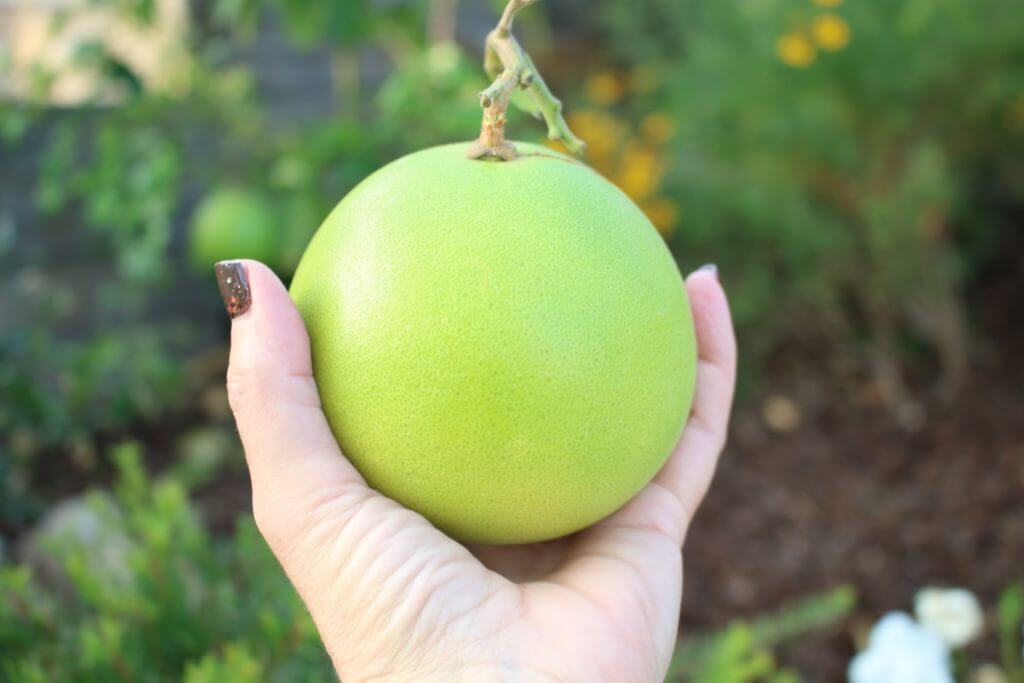How to Use Pomelo

If you’ve ever wondered what to do with a pomelo—that big citrus fruit that looks like a thick-skinned grapefruit—check out these tips on how to use it in the kitchen.
What is a pomelo? Have you ever seen an enormous, spongy, yellow-green citrus fruit, and wondered what it was? Well, these citrus fruits are certainly worth getting to know. I first heard about this fruit a few years ago, which led me to try it and even grow it in my garden in California. That’s my first crop of pomelos I’m holding in the photo below. The more I learn about these sweet-tart fruits, the more fascinated I become. I had no idea that pomelos were so diverse, nor that they are a close relative of the grapefruit. Like grapefruit, pomelos can vary in color from green, pink, or yellow but, unlike their cousin, they can grow to the size of small bowling balls. When comparing tastes, the pomelo has a variety of flavors, ranging from sweet to sour and tangy to tart, which makes this fruit astoundingly versatile in the kitchen.

The pomelo is native to China and Southeast Asia and has grown there for over 4,000 years. It’s considered a symbol of prosperity for the Chinese Lunar New Year, and it’s easy to see why—when you dig through its fragrant skin and thick membrane, you uncover a fresh, jewel-like fruit treasure. The fruit has other uses as well: the tree leaves and flowers are used as traditional Chinese medicines to cure upset stomach, treat excessive thirst, and aid with bronchitis symptoms.
Another alias for the pomelo is “Shaddock,” named after the English captain who brought pomelo plants to the West Indies in the 17th century. It was there that the pomelo tree cross-bred with the sweet orange tree to create the grapefruit. Due to the suitable climate, the grapefruit prospered and became the Western culture’s version of pomelos. The common orange and mandarin are also thought to be relatives of the pomelo.


There are many nutritional benefits for consuming pomelos, as they are an excellent source of vitamin C, potassium, fiber, and limonene, a phytochemical which has antioxidant effects. According to a 2010 study by the Institute of Nutrition, Mahidol University, Thailand, pomelos are a better source of flavonoids (a group of phytochemicals) than a number of other tropical fruits, including guava, durian, and papaya. Flavonoids have been shown to have anti-oxidative activity, increase free-radical scavenging capacity, help prevent coronary heart disease, and slow anticancer activity. Flavonoids are found in many fruits and vegetables, which is one reason why nutrition experts recommend consuming at least six servings of them daily to obtain all of the nutritional benefits that they offer.


Top 5 Ways to Use Pomelo

1. Toss it into a Salad. Pomelos are extremely versatile in the kitchen, due to their unique flavor and texture. They pair well with herbs, such as mint, cilantro, and basil; fruits, like pineapple, coconut, and mango; and spring vegetables, including carrots, radishes, jicama, and onions. Try slicing pomelo into this recipe featuring grapefruit—it’s a quick trade.

2. Add Them to Savory Dishes. Heat can make the pomelo bitter, but you can add this fruit to hot dishes at the end of cooking. Try pomelo in savory dishes that usually call for lemon or orange, such as stir-fries and tofu dishes. Just slice the fruit and add at the end. You can also shred the outer peel for pomelo zest to substitute for lemon or orange in recipes.

3. Blend it Up. Smoothies are one of the best go-to snacks or breakfasts when you’re on the go or simply craving something refreshing. Think out of the box by adding pomelo to your next smoothie, slushie, mixed drink, popsicle, sorbet, ice, or smoothie bowl for extra flavor and pizzazz. You can also combine it with other citrus fruits in recipes for a super-citrus flavored beverage.

4. Pair it Harmoniously. Try pairing pomelo with complimentary plant foods, such as avocado (the citrus cuts the creaminess of avocado and helps maintain its bright colors too), deep leafy greens, crunchy nuts, and savory grains. Take a great recipe to the next level, compliments of pomelo. It’s sure to be a major hit with anyone who tries it, as well as something new and adventurous to jazz up your menus.

5. Bake it Up. For a nice, fruit-forward dessert, turn to pomelo to give it a juicy, sweet-tart finish. Just add pomelo segments with other fruit, such as berries, peaches, and plums to bake up your next cobbler, crisp, or crumble.
For more inspiration on how to cook with plant foods, check out the following ideas:
Top 5 Ways to Use Sweet Potatoes
Top 5 Ways to Use Blackberries
Top 5 Ways to Use Avocados
Top 5 Ways to Use Romanesco


